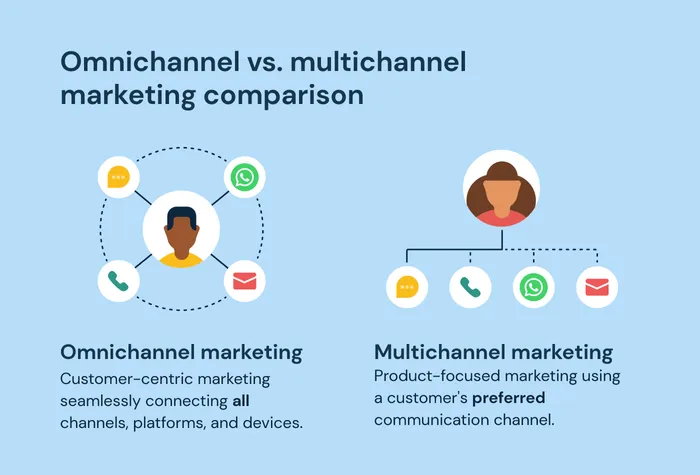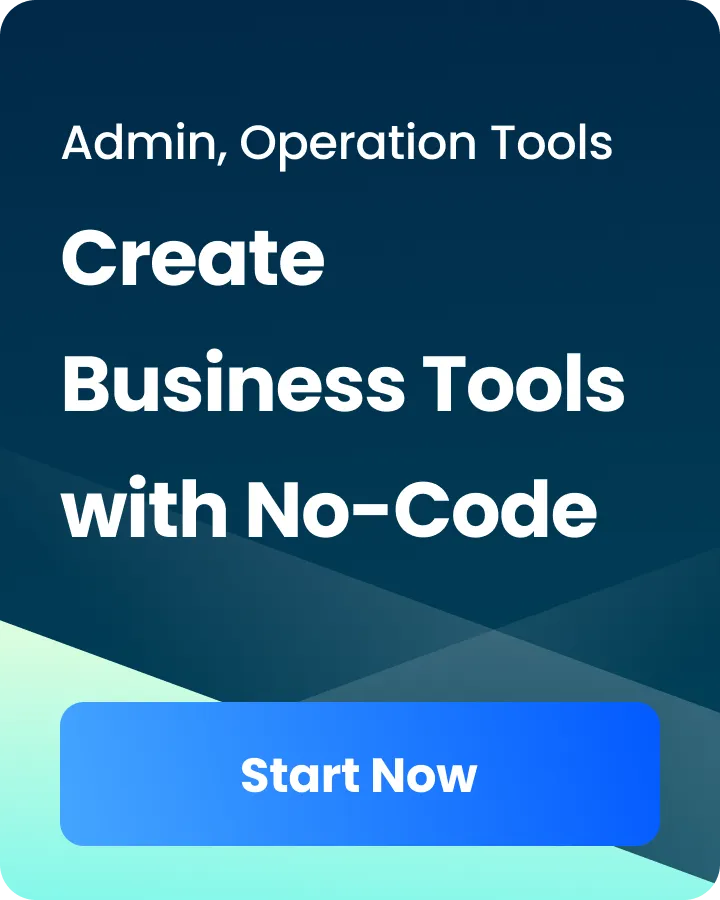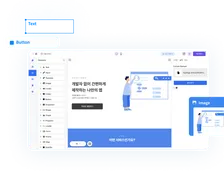Marketing
What is Omnichannel marketing automation?
Sanchita
3/5/2024
0 min read
TABLE OF CONTENTS
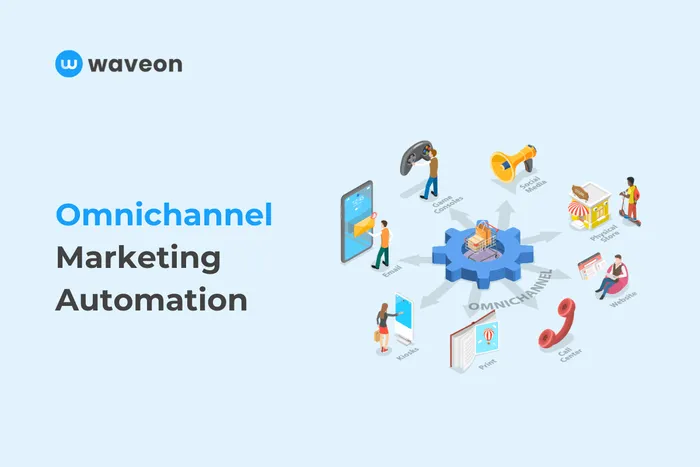
Imagine this. A customer browses your website, adds an item to their cart, abandons it mid-checkout, gets bombarded with generic emails, and finally disappears, frustrated and forgotten.
Sound familiar? This is the reality of traditional multichannel marketing. It's completely missing the rhythm that’s needed for the digital world.
Almost all modern customers jump between devices, channels, and touchpoints throughout their journey. This means you must pursue theme throughout all the channels and not only the one they started from.
That’s where omnichannel automation ensures you're there, meeting their needs at every step, not just the first or last.
Let’s explore omnichannel marketing automation and how it can help you win more business.
Understanding Omnichannel Marketing Automation
Omnichannel marketing automation means automating omnichannel marketing. But what is omnichannel marketing?
Its marketing approach creates a unified message across all the channels to provide an integrated shopping experience. In the omnichannel approach, marketers acknowledge that although a customer might start their journey from one channel, they can end it on other channels. For example, customers see a brand on Instagram and then move to a website to make the purchase.
Now, let’s move to the implementation part, which is not highlighted much. Every brand’s omnichannel marketing automation will look unique.
Omnichannel Is Not Multichannel: Here’s The Basic Differences
Omnichannel and multichannel are often used interchangeably, but a crucial distinction exists, emphasizing the need for businesses to understand and adopt a genuine omnichannel approach.
Multichannel utilizes various channels for customer interactions but operate in isolation, lacking synchronization. In contrast, omnichannel integrates these channels seamlessly, ensuring a cohesive and interconnected user experience.
The fundamental difference lies in the level of integration and continuity throughout the customer journey.
While multichannel might create siloed interactions, omnichannel fosters a unified experience, enabling customers to transition effortlessly between channels without losing context. This distinction underscores the importance of not merely deploying multiple channels but orchestrating them harmoniously to deliver a truly integrated and holistic experience, thereby enhancing customer satisfaction and loyalty.
How To Implement Omnichannel Marketing Automation?
To implement omnichannel marketing automation, follow these general steps:
1. Define your customer journey map and identify touchpoints across various channels
According to a survey by McKinsey, companies with a well-defined customer journey map are 57% more effective at increasing customer satisfaction. By carefully mapping the customer journey, you can gain insights into touchpoints and critical interactions. This way you can develop more targeted marketing strategies, ensuring alignment with customer behavior and preferences.
2. Collect and consolidate customer data from all channels and systems. Ensure data hygiene and accuracy
Efficient data collection from diverse channels establishes a robust customer database. This centralized repository supports personalized marketing, enhances customer segmentation, and facilitates data-driven decision-making, ensuring reliable and accurate information for effective omnichannel marketing automation.
3. Select marketing automation tools that fit your requirements and budget
Choosing suitable automation tools is paramount for seamless orchestration of marketing efforts. Platforms that integrate seamlessly with existing systems, offer scalability, and fit within budget constraints provide the foundation for streamlined and cohesive omnichannel marketing automation strategies.
4. Map out your customer segments and develop targeted campaigns for each group
Analyzing customer data reveals distinct segments based on demographics and behavior. Targeting these segments allows for the creation of personalized and relevant campaigns, fostering higher engagement, and increasing the likelihood of successful conversions in the omnichannel landscape.
5. Design personalized messages and content for each channel, ensuring consistency throughout the customer journey
Crafting content tailored to each customer segment using personalization features enhances engagement and loyalty. Consistent messaging across channels ensures a cohesive brand experience, reinforcing the brand's identity and resonating with diverse audiences in the omnichannel environment.
6. Test and refine your campaigns continuously to optimize performance
Implementing A/B testing enables the identification of optimal campaign elements. Continuous refinement based on performance insights maximizes engagement and conversion rates. This iterative process ensures that marketing efforts evolve to meet changing customer preferences and deliver improved results in the omnichannel space.
7. Monitor and evaluate the effectiveness of your omnichannel marketing efforts using key performance indicators (KPIs)
Setting and tracking key performance indicators (KPIs) aligns marketing efforts with business goals. Regular evaluation of these metrics provides actionable insights, enabling data-driven decisions, pinpointing areas for improvement, and demonstrating the return on investment (ROI) of omnichannel marketing automation initiatives. Monitoring KPIs ensures ongoing optimization and success measurement.
Key performance indicators (KPIs) and metrics are as follows:
Conversion rates
Cost per acquisition (CPA)
Average order value (AOV)
Customer lifetime value (CLV)
Churn rate
Net promoter score (NPS)
Customer satisfaction rate
Shopping cart abandonment rate
Brand advocacy
Brand awareness metrics (e.g., CPM)
Top Omnichannel Marketing Automation Platforms In 2024?
1. ActiveCampaign
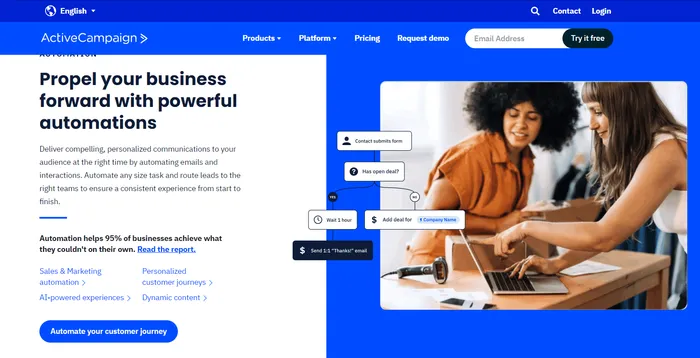
ActiveCampaign is an omnichannel marketing automation platform that allows businesses to automate and personalize their marketing campaigns across multiple channels, including email, SMS, social media, and more.
Highlighting Features
-
ActiveCampaign offers a flexible and adaptable cross-channel engagement approach that supports customer engagement across every channel that matters
-
ActiveCampaign offers a drag-and-drop email builder with over 250 responsive templates, over 800 pre-built automation recipes, predictive routing, timing, and content for campaigns, and advanced segmentation options to more effectively speak to target audiences.
-
Create onsite campaigns, such as popups, that guide, collect, and connect with visitors beyond the inbox.
-
It offers advanced audience segmentation, allowing users to easily create dynamic segments based on a variety of factors using user data. This helps businesses more effectively design campaigns to reach specific customers with highly targeted messages.
-
ActiveCampaign offers over 870 seamless integrations with other tools and platforms, allowing businesses to connect their tools and gather the right data
2. ConstantContact
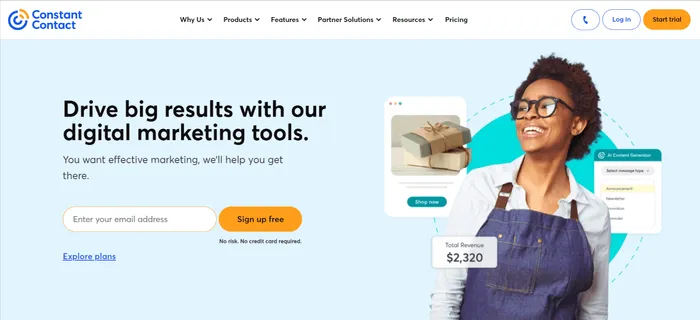
Constant Contact offers marketing automation tools that can help businesses implement omnichannel marketing automation. With Constant Contact, businesses can gather data about their clients and segment their marketing based on their demographics and interests.
Constant Contact also offers several key features that set it apart from other marketing automation platforms, including artificial intelligence (AI) content generation, beginner-friendly automation tools, and omnichannel marketing automation.
Highlighting Features
-
Constant Contact's marketing automation tools allow businesses to send targeted emails to customers automatically based on how they engage with emails
-
It allows businesses to add, store, and organize their contacts in one place and segment lists to target the right people
-
The reporting capabilities allow businesses to see who's opening, clicking, and sharing their emails, spot trends, and plan their next steps
-
Constant Contact offers hundreds of professionally-designed email templates that businesses can customize to make their own.
-
It integrates with other tools like CRMs, e-commerce platforms, and social media management tools to gain a holistic view of the customer journey
-
Constant Contact's platform allows businesses to save time creating, scheduling, and posting all of their social engagement from one place.
-
SMS text messaging: Constant Contact's platform allows businesses to send SMS text messages to customers as part of their omnichannel marketing strategy
-
Constant Contact's platform allows businesses to add new signups to specific contact lists through customizable pages with unique URLs
3. GetResponse
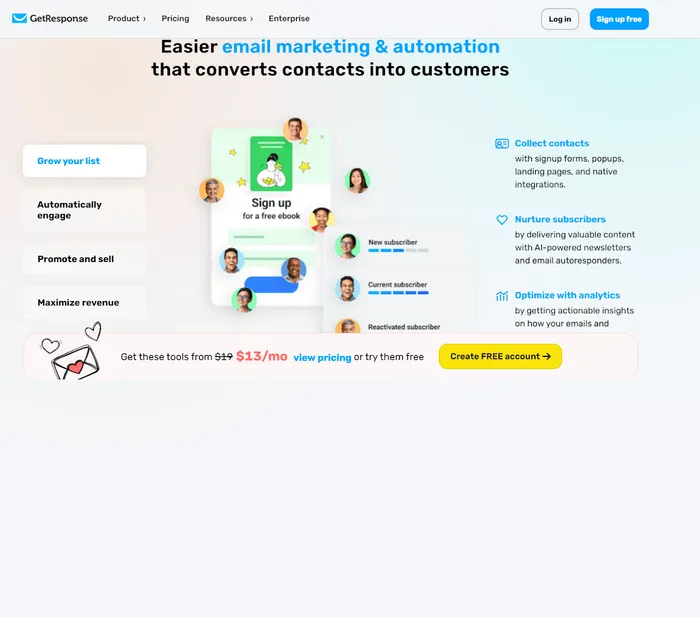
GetResponse is an omnichannel marketing powerhouse founded in 1998. Since then, they've evolved alongside the needs of modern businesses, offering robust features designed to help you thrive in the competitive landscape.
Imagine knowing your customers inside-out? That’s what GetResponse helps you with. It gathers data from email, SMS, website interactions, and even abandoned carts, creating a 360-degree view of your audience. This allows you to segment precisely and craft personalized campaigns that resonate deeply.
Highlighting Features.
-
No more guesswork. GetResponse's reporting and analytics suite gives you clear insights into campaign performance across all channels.
-
Design intuitive workflows triggered by specific actions, like welcoming new subscribers, re-engaging dormant customers, or sending personalized product recommendations. It's marketing efficiency at its finest!
-
Pinpoint your target demographics based on different parameters, ensuring your campaigns reach the right person.
-
Test different elements of your marketing strategies to uncover what resonates best with your audience, optimizing your approach for maximum impact.
4. Drip
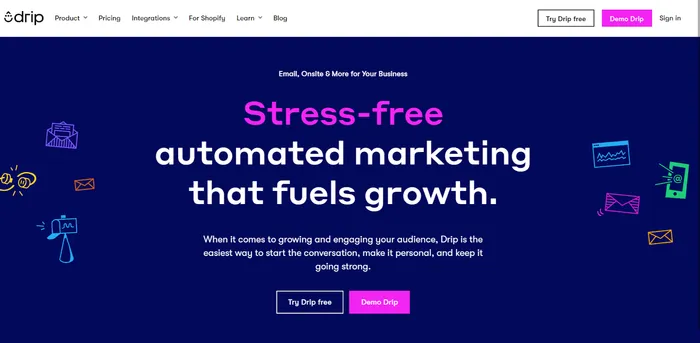
Drip is a marketing automation tool that allows businesses to run multichannel marketing strategies on autopilot, including email, onsite, and social media channels using data from their order management system and integrations.
Using Drip for omnichannel marketing automation offers several benefits, including personalized communication, saving time and resources, increased ROI, and improved customer retention. With Drip campaigns, you can nurture leads, boost customer engagement, and increase conversions by delivering targeted and timely content, thereby fostering stronger customer relationships and driving overall marketing effectiveness. You can also customize for the interests and behavior of the target audience, leading to higher response and engagement rates and increased conversion rates.
Highlighting Features
-
Drip offers a "What You See Is What You Get" (WYSIWYG) email editor for code-free email design. It also provides numerous automations with customizable pre-built workflows to effectively speak to target audiences.
-
Gives businesses to create onsite campaigns, such as popups, that guide, collect, and connect with visitors beyond the inbox.
-
It advanced audience segmentation, allowing users to easily create dynamic segments based on a variety of factors using user data.
-
Dashboards give you a full overview to see the impact of their marketing strategies and adjust and improve them accordingly.
-
Drip offers over 150 seamless integrations with other tools and platforms, allowing businesses to connect their tools and gather the right data.
5. Klaviyo
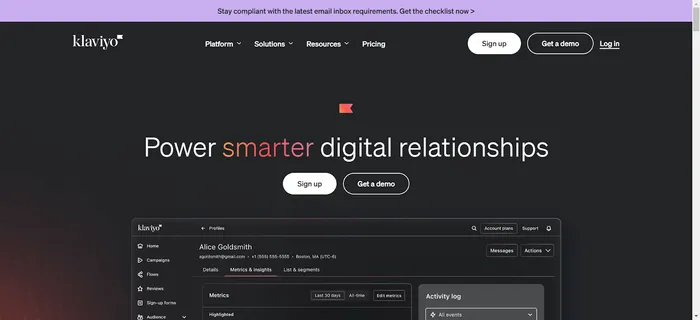
Founded in 2012, Klaviyo is today one of the most preferred omnichannel marketing automation platforms for e-commerce businesses.
Highlighting Features
-
It gathers data from various sources like email, SMS, web behavior, and in-app actions, building a holistic customer profile. This allows for highly targeted and relevant communication across channels.
-
Helps design automated workflows activated by specific actions or events. For example, welcome new customers via email, follow up on abandoned carts with SMS reminders, or send personalized product recommendations based on browsing behavior.
-
Klaviyo integrates with email, SMS, push notifications, Facebook Messenger, and more, allowing you to deliver personalized messages through the channels your customers prefer.
-
You can track performance across channels and gain valuable insights to refine your strategy
Benefits of Omnichannel Marketing Automation
1. Seamless User Experience
Omnichannel marketing automation is extremely important in delivering a seamless user experience. By unifying communication across platforms and channels, you can ensure consistency in messaging, branding, and user interface. This consistency leads to enhanced user satisfaction, increased brand loyalty, and a reduction in user friction, ultimately resulting in improved conversion rates.
2. Simplified Marketing
The complexity of modern marketing requires a streamlined approach. Omnichannel marketing automation simplifies marketing efforts by centralizing control and automating repetitive tasks. This allows marketing teams to focus on strategic planning, creativity, and adapting campaigns based on real-time insights, thereby maximizing the impact of marketing initiatives.
3. Boosted Engagement Through Data
Data-driven decision-making is a cornerstone of successful marketing strategies. Omnichannel marketing automation empowers businesses to collect, analyze, and leverage customer data across multiple touchpoints. By understanding customer behaviors and preferences, businesses can deliver personalized and targeted campaigns, significantly increasing engagement and fostering stronger customer relationships.
4. Emphasis on the Customer Journey
Omnichannel marketing automation enables businesses to map and optimize the entire customer journey. By establishing consistent messaging and experiences, customers seamlessly transition between channels. This emphasis on the customer journey ensures that every interaction aligns with the overall brand narrative, enhancing customer satisfaction and increasing the likelihood of repeat business.
5. Less Work and Cost Savings
Efficiency and cost-effectiveness are critical considerations for any business. Omnichannel marketing automation reduces manual workload by automating routine tasks such as email campaigns, social media posting, and customer segmentation. This not only frees up resources but also leads to substantial cost savings over time, making the investment in automation a prudent business decision.
Conclusion
Adopting omnichannel marketing automation is imperative for businesses aiming for sustained growth and a competitive advantage. We have given you the blueprint to implement the omnichannel marketing automation. Now it's your turn. . The shift towards omnichannel marketing automation is not just a trend; it's a strategic imperative for businesses looking to excel in today's competitive market.

